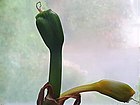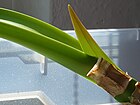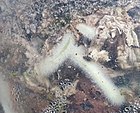|
Hippeastrum calyptratum
Hippeastrum calyptratum is a flowering perennial herbaceous bulbous plant, in the family Amaryllidaceae, native to Brazil. DescriptionThis species has an approximately 7.5 cm wide, globose bulb, which is enclosed in persistent, brown leaf bases. The bulbs bear 5-6, approximately 45 – 60 cm long, 5 cm wide, light green leaves.[2] The green flowers are produced in Autumn[3] on 2-3 flowered umbels, which are supported by terete, green, about 60 cm long, and about 1.3 - 1.9 cm wide peduncles.[2] Semi-discoid, flattened seeds are produced in globose-compressed capsule fruits.[4]
ConservationThis species is probably threatened by extinction, however not enough data is currently available on its distribution, and thus the proposed IUCN conservation Status is Data Deficient (DD).[5] EcologyThe flowers are pollinated by bat species.[6] It occurs in humid Atlantic Rainforest at elevations of 1200 m above sea level growing epiphytically on mossy trees or as a lithophyte on rocks.[3]  CytologyThe diploid chromosome count of this species is 2n = 22.[7] PhysiologySeveral crinine-type alkaloids have been isolated from tissue of this species.[8] The floral scent, which has been described as stale, sour, fermented,[6] or similar to burnt plastic[3] is composed of the following compounds: 1,8-cineole, perillene, camphor, linalool, limonene, g-terpinene, b-myrcene, sabinene, a-pinene, d-3-carene, and 3-hexanone.[6] TaxonomyThis species was first described under the name Amaryllis calyptrata by John Bellenden Ker Gawler (Ker Gawl.) in 1817. Later it was transferred to the genus Hippeastrum under the name Hippeastrum calyptratum by William Herbert (Herb.) in 1821.[1] EtymologyThe specific epithet calyptratum is derived from the Latin calyptratum meaning "bearing a calyptra" or the Greek kalypto, kalyptra meaning "to hide" or "veil".[9] CultivationThe cultivation is thought to be difficult by some growers unfamiliar with the specific needs of epiphytes. In contrast to other members of the genus, the substrate should be coarse, aerated, and well drained for this species.[3] References
SourcesWikispecies has information related to Hippeastrum calyptratum.
|
||||||||||||||||||||||||||||||||||||||||||







